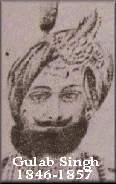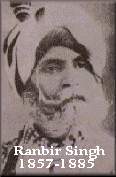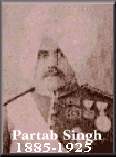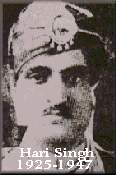




 |
 |
|
|
 |
 |
Tradition has it that Kashmir was originally a lake that was drained by Kashyap and then inhabited by the Brahmins. Buddhism was introduced by the missionaries of Ashoka and flourished under the rule of Kushan in 2nd Century AD. However, Hinduism continued to be the dominant religion. In the 7th Century AD, the Karkota dynasty was founded by Durlabhavarrdhana. In 855 AD the Utpalas replaced the Karkotas. Later, the Tantrins, Yaskaras and Parva Gupta ruled in succession. Didda, a Gupta widowed queen, ruled Kashmir until 1003 AD when the Lohara dynasty took over. In 1346 AD the last Hindu king, Udiana Deva, was replaced by Shams-ud-Din. His family ruled until 1586 when the Moghul emperor Akbar conquered and annexed Kashmir to his vast empire. In 1757 it was conquered by Ahmed Shah Durrani and became part of Afghanistan. In 1819 Ranjit Singh conquered Kashmir and made it part of his Sikh empire. In 1846, when the British defeated the Sikhs and annexed Punjab, they sold Kashmir to Ghulab Singh of Jammu for Rs. 7.5 million under the Treaty of Amritsar. Ghulab Singh, who entitled himself the Mahrajah, signed a separate treaty with the British which, in effect, gave him the status of an independent princely ruler of Kashmir. He added to his dominion by conquering Ladakh. Ghulab Singh died in 1857 and was replaced by Rambir Singh (1857-1885). Two other Marajahs, Partab Singh (1885-1925) and Hari Singh (1925-1949) ruled in succession. Ghulab Singh and his successors ruled Kashmir in a tyrannical and repressive way. The people of Kashmir, nearly 80% of whom were Muslims, rose against Mahraja Hari Singh's rule. He ruthlessly crushed a mass uprising in 1931. In 1932 Sheik Abdullah formed Kashmir's first political party - All Jammu & Kashmir Muslim Conference (renamed to National Conference in 1939). In 1934 the Maharajah gave way and allowed limited democracy in the form of a Legislative Assembly. However, unease with the Maharaja's rule continued. According to the instruments of partition of India in 1947, the rulers of princely states were given the choice to freely accede to either India or Pakistan, or to remain independent. They were, however, advised to accede to the contiguous dominion, taking into consideration the geographical and ethnic issues. In Kashmir, however, the Maharajah hesitated. The principally Muslim population having seen the early and covert arrival of Indian troops, rebelled and things got out of the Maharajah's hands. The people of Kashmir were undoubtedly demanding to join Pakistan. The Maharajah, fearing tribal warfare, eventually gave way to the Indian pressure and agreed to join India by 'signing' the Instrument of Accession on 26th October 1947. Kashmir was provisionally accepted into the Indian Union pending a free and impartial plebiscite. This was spelled out in a letter from the Governor General of India, Lord Mountbatten, to the Maharajah on 27th October 1947. In the letter, accepting the Accession, Mountbatten made it clear that the state would only be incorporated into the Indian Union after a reference had been made to the people of Kashmir. Having accepted the principle of a plebiscite, India has since obstructed all attempts at arranging one. Heavy fighting took place in 1947-48 between the Indian and Pakistani forces over Kashmir. On 1st January 1949 a cease-fire was declared which created the first Line-of-Control. In 1957 the state was, in effect, incorporated into the Indian Union under a new Constitution. This was done in direct contravention of the standing UN resolutions and the conditions of the Instrument of Accession. The article was rushed through by the then puppet state government of Bakshi Ghulam Mohammed; people of Kashmir were not consulted. Heavy fighting broke out again in 1965 between India and Pakistan over Kashmir. A cease-fire was established in September 1965. Indian Prime Minister, Lal Bhadur Shastri, and Pakistani President, M Ayub Khan, signed the Tashkent agreement on 1st January 1966. They resolved to try to end the dispute by peaceful means. In 1971 civil war broke out in East Pakistan and Indian forces again fought the Pakistani forces in Kashmir. This resulted in a new cease-fire and the signing of the Shimla Agreement by Indira Ghandi and Z A Bhutto. The Shimla Agreement basically reiterated the promises made in Tashkent. Since the 1971 war, the situation may have been described as stalemate with India in control of much the larger part of Kashmir, and doing everything to emphasis her claim de jur. However, the dream of freedom from India never died; it was only suppressed from time to time by the Indians by using puppet state governments. Guardian on 14th July 1970 reports that it is "ironic that India's position in Kashmir should be increasingly challenged from within at a time when Kashmir's status as a major unsettled international dispute is declining". Hindustan Times of August 1970 reports, "In the Kashmir People's Convention held in Srinagar in the summer of 1970, but for a few feeble voices in our [India's] favour, most of the delegates favoured either accession to Pakistan or creation of an independent Kashmir". The close of 1989 saw the beginning of the renewed struggle for freedom of Kashmir. The Kashmiris started to arm themselves to resist the Indian occupation. The then state government, headed by Dr Farooq Abdullah, was dissolved and the state placed in direct control of the governor. Since then the struggle for freedom and democracy has intensified.